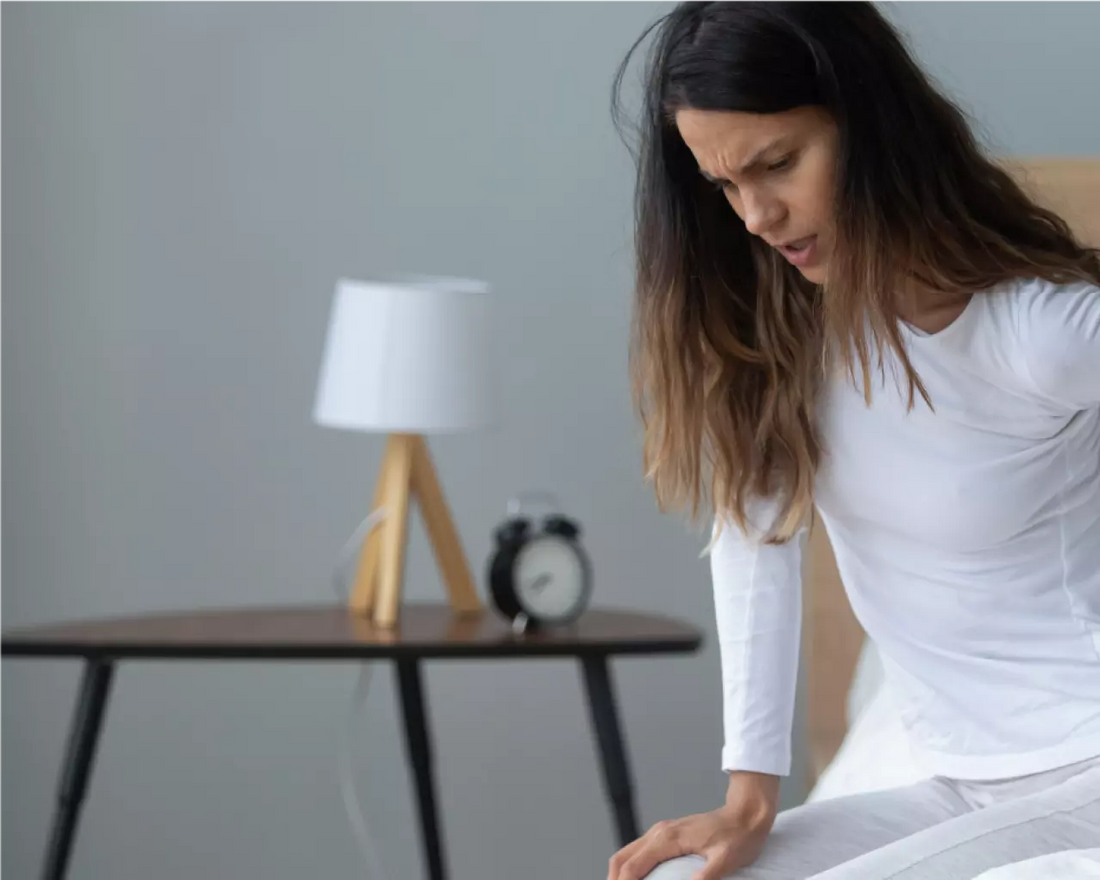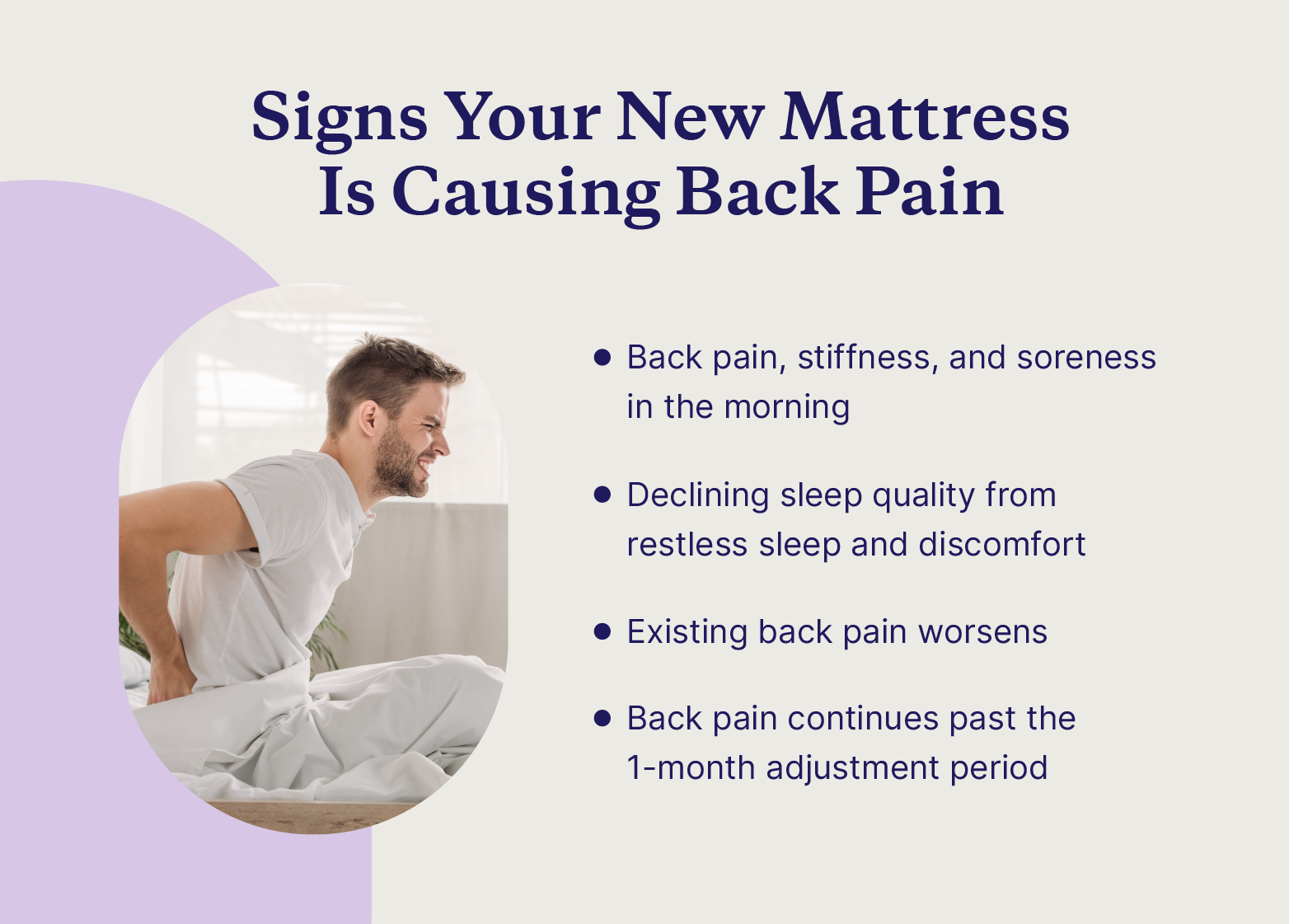
Is Your New Mattress Giving You Back Pain? Why & How To Fix It
Share
Over 500 million people report having lower back pain (LBP), according to a Global Spine Care Initiative study. LBP is a major sleep disturbance that can either be exacerbated or improved by your mattress.
If you have pre-existing back pain that has worsened or have experienced back pain since investing in a new mattress, you’re in the right place.
This post will go over the signs that your bed may be the cause of your back pain and guide you on choosing the right mattress. Additionally, you’ll find details on equipping your mattress with the right base, toppers, and pillows to support your back for a better night's sleep.
Signs Your New Mattress Is Causing Back Pain
If you’re consistently waking up to discomfort and back pain that subsides gradually throughout the day, your mattress is likely the cause. You may also find that getting comfortable in bed has been increasingly difficult since purchasing your new mattress or your existing back pain has gotten worse. If you can date these physical symptoms since the day of purchase, the culprit is pretty clear.

Your Mornings Start With Back Pain, Stiffness, and Soreness
If you wake up with pain, stiffness, and soreness in your back, and the feeling gradually goes away through the day, your mattress is likely the cause. Pain doesn’t have to be limited to the back — it can also extend to other parts of your body. Some additional symptoms that may suggest your mattress is the issue include:
- Neck, shoulder, and hip pain from poor alignment
- Joint stiffness if your mattress doesn’t support neutral sleeping positions
- Numbness and tingling from poor circulation
These symptoms can also vary depending on your sleeping position. Different sleeping positions tend to work better with different mattress firmness levels. Below are ideal mattress firmness levels based on sleeping position:
Back sleepers: Medium-firm
Medium to firm mattresses help maintain proper spinal alignment and support the natural curve of the lower back. Memory foam, latex, or hybrid mattresses with a balanced firmness level can be good options for back sleepers.
Side sleepers: Medium-soft
Side sleepers need a mattress that offers good pressure relief, especially at the shoulders and hips. A softer mattress with adequate cushioning, such as a memory foam or latex mattress, can contour to the body's curves and reduce pressure points.
Stomach Sleepers: Firm
Stomach sleepers typically need a firmer mattress to prevent their midsection from sinking too deeply, which can cause an unnatural curve in the spine. Innerspring or hybrid mattresses with a firmer feel are often a good choice.
Your Sleep Quality Is Suffering
If you start noticing a decline in your sleep quality from restless sleep, it could be due to physical discomfort from your mattress. Some symptoms resulting from poor sleep quality include:
- Increased irritability and mood swings
- Difficulty concentrating
- Impaired memory
While physical pain, stiffness, and soreness may occur from an unsupportive mattress, your cognitive functions suffer when your sleep quality declines. Your brain needs sufficient, uninterrupted sleep to do its job, so it’s time to replace your mattress if it’s getting in the way of your sleep quality.
Existing Back Pain Worsens
If you already have some degree of back pain and you notice that it worsens after sleeping on your new mattress, this is a clear sign of a mattress-related issue. The mattress shouldn’t exacerbate existing back problems but should instead provide relief.
In addition to your existing back pain, if you experience increased stiffness, persistent and more intensified pain, and the pain spreading to different parts of your back, it’s time to change your mattress to prevent making your condition worse.
It’s Been Over a Month
There is often an adjustment period when you get a new mattress. You can generally start to adjust within a month, but if you’re still experiencing pain, stiffness, and soreness after this period, it’s a clear sign that your body can’t adjust to the mattress.
If within one month you haven’t experienced the following, your new mattress may be a bad match for your sleeping needs:
- Decreased comfort as it becomes harder to fall asleep
- Increase tossing and turning as your mattress provides little to no support
- Worse sleep quality from interrupted sleep
Why Your New Mattress Causes Back Pain
Your new mattress can be a bad match for you for various reasons. Mattresses should provide support to the natural contours of your body and accommodate multiple sleeping positions. The adjustment period after getting a new mattress may have you experiencing a change in support and sleeping positions to get comfortable which may cause temporary back pain.
Mattress Isn’t Supportive Enough
Your mattress should provide proper spinal alignment, edge support, and even weight distribution unique to your body and sleeping preferences. If you feel your mattress isn’t serving one of the below purposes, it may not be the right fit for you.
- Spinal alignment: The mattress should conform to the body's natural curves and not cause the spine to bend or twist into unnatural positions, especially when learning how to sleep on your back. This means it needs to be responsive enough to meet different sleeping positions while keeping the spine aligned.
- Edge support: This is the support along the edges of your mattress and determines how well it can accommodate those who sleep near the edge of the mattress. It should feel just as supportive as the center, prevent you from rolling off, and provide ease in getting in and out of bed.
- Even weight distribution: A supportive mattress will distribute the sleeper's weight evenly across the bed. This helps promote better circulation for your limbs.
Mattress and Base Don’t Pair Well
The base, or mattress foundation, lies under the mattress and gives it support, elevation, and weight distribution. Not all bases are created equal, and you may be using the wrong base for your mattress. Some common base and mattress compatibilities include:
Box Spring
These bases are made of wood or metal and contain layers of coil covered in fabric.
- Compatibility: Innerspring mattresses
Platform Bed
These are made of wood and metal and provide a flat support. They are the most compatible base for mattresses.
- Compatibility: Innerspring, memory foam, latex, and hybrid mattresses
Slatted Base
These are made of wood and metal and consist of slats (narrow flat planks of wood/metal) horizontally laid across the frame to create a platform. If slats are too far apart, the mattress can start to sag or dip in the areas where support is lacking. This uneven support doesn't just damage the mattress; it can also lead to discomfort or back pain for the user due to improper spinal alignment.
- Compatibility: Innerspring, memory foam, latex, and hybrid mattresses
Adjustable Base
This is a motorized platform that can be adjusted with a remote. Individuals who experience sleep apnea, acid reflux, or poor circulation often opt for this type of base.
- Compatibility: Innerspring, memory foam, latex, and hybrid mattresses
Whether it’s due to the coils piercing through worn fabric or slats spaced too far apart, your mattress base can possibly compromise your mattress support, so it’s important to double-check if you’re using the right base for your mattress.
